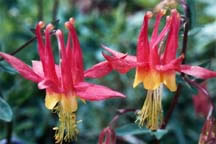Plant Data Sheet

* Picture taken from Native
Plant Society of Oregon web page
(http://www.npsoregon.org/ann/2002.htm)
Species Red/Western Columbine,
Aquilegia formosa
*Note – there are several
geographic races; var. formosa is common in our
area
Range
Widely distributed
in W. North America from S. Alaska and southward. Along coast and in coastal
mountains to N. Baja, CA. Also in higher elevations of Sierra Nevadas.
Distributed equally in Pacific and Cordillera regions.
Climate,
elevation
Low moisture
conditions and lack of sunlight limiting factors. Chiefly montane to subalpine,
occurrence decreasing with increasing elevation.
Local occurrence (where, how
common)
Common from lowlands
to timberline. Mostly in subalpine forests and meadows in Olympics and Cascades.
Habitat
preferences
Moist, open to
partly shaded sites such as meadows, streamsides, rocky slopes and beaches,
forest glades, clearings, and roadsides. Indicator of fresh and moist soils, and
N-rich soils within the subalpine boreal.
Plant strategy
type/successional stage (stress-tolerator, competitor, weedy/colonizer, seral,
late successional)
Inhabits early
seral, exposed moist sites.
Associated species
Paintbrush (Castilleja spp.), Tiger lily (Lilium columbianum), Penstemon spp.
May be collected as: (seed,
layered, divisions, etc.)
Seed. Plants collection doesn’t seem to be
restricted, but is not mentioned as method.
Collection restrictions or
guidelines
Not on threatened
plant list. Hybridizes easily with
other species in the garden, so important to have reliable seed source and avoid
collecting seeds from plants of unknown origin. Seeds mature June-August.
Harvest by hand. Gently crush dried heads to release remaining seeds.
Seed germination (needs
dormancy breaking?)
Scalp seeds with air
screen. Some sources say no cold stratification required. Other sources say cold
stratification required if growing indoors. A 3-day pre-chill is required.
Seed life (can be stored, short
shelf-life, long shelf-life)
2 years or longer
depending on conditions.
Recommended seed storage
conditions
Can be stored up to
2 years in low temperature and low humidity environment. Can be stored longer if stored in sealed
containers in low moisture environment.
Propagation
recommendations (plant seeds, vegetative parts, cuttings,
etc.)
Direct seed
outdoors in fall or sow seeds into containers in spring or
fall.
Soil or medium requirements
(inoculum necessary?)
Prefer mildly acidic
soils (6.1-6.5 PH).
Installation form (form,
potential for successful outcomes, cost)
Seeds or container plants grown from
seeds..
Recommended planting
density
18-24 inches apart
(garden); 1200-3450 per acre per USDA.
Care requirements after
installed (water weekly, water once etc.)
Moist soils
preferred.
Normal rate of growth or
spread; lifespan
Perennial. Puts out
lots of seeds, spreads quickly (non-vegetatively). New plants next year.
Moderate regrowth rate after harvest.
Sources
cited
Hitchcock, C.L., A
Cronquist, M. Ownbey, and J.W. Thompson. 1964. Vascular Plants of the Pacific
Northwest. Part 2: Salicaceae to Saxifragaceae. University of Washington Press,
Seattle WA. 597 p.
Klinka, K., V. J.
Krajina, A. Ceska, and A.M. Seagel. 1989. Indicator Plants of Coastal British
Columbia. University of B.C. Press, Vancouver, B.C. 288p.
Kruckeberg, A.R.
1982. Gardening with Native Plants. University of Washington, Seattle, WA. 252
p.
Manning, H. 1979.
Mountain Flowers of the Cascades and Olympics. The Mountaineers, Seattle, WA. 96
p.
The Plants Database.
Dave’s Garden, Inc. http://plantsdatabase.com.
Pojar, J. and A.
MacKinnon. 1994. Plants of the Pacific Northwest Coast: Washington, Oregon,
British Columbia, and Alaska. Lone Pine Publishing, Vancouver, B.C. 526
p.
Rose, R., C.E.
Chachulski, and D.L. Haase. 1996. Propagation of Pacific Northwest Native
Plants: A Manual, Volume One, First edition. Forestry Publications Office,
Oregon State University, Corvallis, OR. 66 p.
USDA, NRCS. 2002.
The PLANTS Database, version 3.5 (http://plants.usda.gov/). National Plant Data
Center, Baton Rouge, LA 70874-4490 USA.
Data compiled by:
Marlo Mytty, 9 April
2003